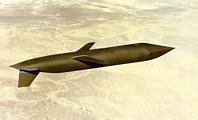US Air Force Decides to Retire Advanced Cruise Missile

The U.S. Air Force has decided to retire the Advanced Cruise Missile, the most modern and capable nuclear cruise missile in the U.S. arsenal, according to information obtained by the Federation of American Scientists.
The decision affects approximately 400 ACMs (AGM-129A) currently deployed at Minot Air Force Base in North Dakota and Barksdale Air Force Base in Louisiana. Each missile carries a W80-1 warhead with a yield of 5-150 kilotons. The ACM is designed for delivery by B-52H strategic bombers.
FAS analyst Hans Kristensen noticed elimination of funding for the ACM in the Air Force’s FY2008 budget request, and a subsequent email to the Air Force confirmed the decision to retire the weapon system. The Air Force has not announced when the retirement will be completed, but it appears to be within the next year.
The decision to retire the ACM is part of the reduction of strategic nuclear warheads under the 2002 SORT agreement (Moscow Treaty), which limits U.S. and Russian operationally deployed strategic nuclear warheads to a maximum of 2,200 by 2012. To meet the treaty limit, the United States already has reduced the number of nuclear warheads on sea-launched ballistic missiles and is in the middle of a download of warheads from land-based ballistic missiles. Confirmation of the ACM retirement is the first public statement about a reduction of warheads on the bomber force.
The ACM is one of two nuclear cruise missiles in the U.S. arsenal, but the only nuclear cruise missile built with stealth technology to evade radar detection. The ACM, which has hard target kill capability, was produced by General Dynamics between 1987 and 1993. The initial plan was to produced nearly 1,500 missiles but the program was cut back to 460 missiles in 1991. The Air Force has not decided what to do with the retired ACM airframes, but is exploring alternative uses such as converting them to carry conventional warheads or use in missile tests.
The Air Force also has an inventory of approximately 1,300 older Air Launched Cruise Missiles (AGM-86B), which also carry the 80-1 warhead. The Air Launched Cruise Missile (ALCM) has just completed a life-extension program, and funding continues through 2013. It is estimated that the ALCM force will be reduced by two-thirds over the next five years.
The United States currently has total stockpile of nearly 9,900 nuclear warheads, of which roughly 4,700 are operationally deployed. Approximately 2,000 warheads are in the Responsive Force, a reserve of extra warheads available to increase the operational force if necessary. The remaining 3,000 warheads are scheduled to be dismantled. After the reductions under the SORT agreement are completed in 2012, the United States will still have a nuclear stockpile of nearly 6,000 warheads.
Background: Status of World Nuclear Forces
The FY2026 National Defense Authorization Act (NDAA) paints a picture of a Congress that is working to both protect and accelerate nuclear modernization programs while simultaneously lacking trust in the Pentagon and the Department of Energy to execute them.
While advanced Chinese language proficiency and cultural familiarity remain irreplaceable skills, they are neither necessary nor sufficient for successful open-source analysis on China’s nuclear forces.
Satellite imagery has long served as a tool for observing on-the-ground activity worldwide, and offers especially valuable insights into the operation, development, and physical features related to nuclear technology.
This report outlines a framework relying on “Cooperative Technical Means” for effective arms control verification based on remote sensing, avoiding on-site inspections but maintaining a level of transparency that allows for immediate detection of changes in nuclear posture or a significant build-up above agreed limits.